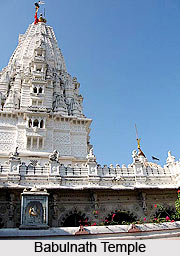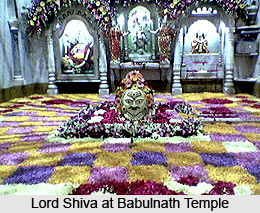 One of the most ancient temples in Mumbai, Lord Shiva in the form of a Babul tree is the presiding deity of the Babulnath temple. Situated at the end of Marine Drive and South of Malabar Hill, the temple is nearly 1000 feet above the sea level, overlooking the Arabian Sea. The temple was built in 1780 and is one of the most spacious temple complexes in the city. In 1900, a tall spire was added to the original construction, which has considerably enhanced the aesthetic beauty of the temple. Such is the glory of the temple that one is reminded of Mount Kailash, Lord Shiva`s perpetual abode.
One of the most ancient temples in Mumbai, Lord Shiva in the form of a Babul tree is the presiding deity of the Babulnath temple. Situated at the end of Marine Drive and South of Malabar Hill, the temple is nearly 1000 feet above the sea level, overlooking the Arabian Sea. The temple was built in 1780 and is one of the most spacious temple complexes in the city. In 1900, a tall spire was added to the original construction, which has considerably enhanced the aesthetic beauty of the temple. Such is the glory of the temple that one is reminded of Mount Kailash, Lord Shiva`s perpetual abode.
The temple is always abuzz with festivities, especially on Mondays, which is the main day of worship. A stone "Lingam" of Shiva is worshipped in Babulnath temple. In the month of "Shravan" or August/September, which is associated with Lord Shiva, millions of devotees visit the Babulnath temple to offer milk to the "Shivling". The temple is visited by lakhs of devotees on annual Maha Shiv Ratri festival. The "Shivling" is believed to be the head of Lord Shiva, and it is venerated amidst the holy chanting of the mantra "Om Namah Shivay". With thousands of devotees thronging the temple everyday for offering their prayers to Lord Shiva, the ambiance of the Babulnath Temple is always that of a religious celebration.
Legend of Babulnath Temple
In the 12th century, the Hindu King Raja Bhimdev placed the holy Shiva Linga and idols at the Babulnath Temple. These remained buried underground and were lost over a period of time. The temple was rediscovered in modern times, when the 5 original idols were dug out.Today the idols of Lord Shiva, Parvati, Ganesh and Hanuman are in the temple but the 5th idol was immersed in water because it was broken.

As per legend, about 300 years back the place where Malabar hills are located today was a big pasture. Majority of the land in that area was owned by a rich goldsmith named Pandurang. He had many cows that were looked after by a cowherd "Babul". In the herd there was one cow named "Kapila". That cow used to give plenty of milk like other cows, due to the abundance of green grass. One evening, Pandurang saw that Kapila cow did not give even a single drop of milk. He asked his cowherd Babul and was shocked to hear the answer. Babul said that it was not the first time Kapila had not given milk; rather, it was a daily practice. According to him, the Kapila cow daily poured out her entire milk at one particular spot in the field. The next day Pandurang went to find out the truth and was amazed to see it happen. He asked his men to dig the place and found a Swayambhu, i.e., a self-existent Shivling carved in black stone. That place is now worshiped as the "Babulnath Temple". This was primarily the inspiration behind the building of the Babulnath temple, on this sacred spot. People flock to this temple in search of peace and tranquillity, because the sheer beauty of the architecture reminds one of Mount Kailash, the eternal home of Lord Shiva.
Architecture of Babulnath Temple
The temple"s marvellous architecture and carved interiors are worth seeing, as the temple gives an illusion of Mount Kailash. The entire ceiling and pillars of the Babulnath Temple are adorned with beautiful images from Hindu mythology.
Route to Babulnath Temple
The Babulnath temple is well accessible from all corners of the city. The nearest station is Grant Road, and from there one can hire a taxi, auto-rickshaw to reach the temple.











